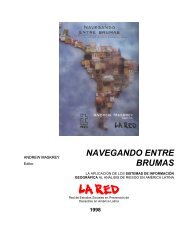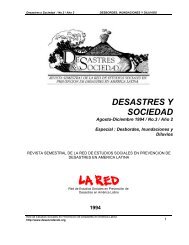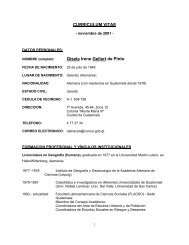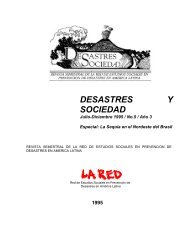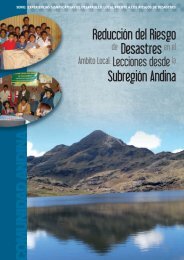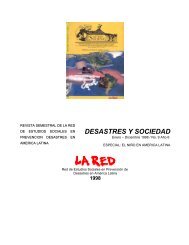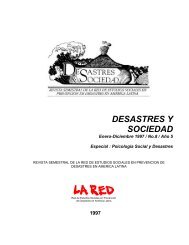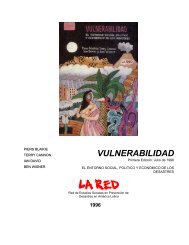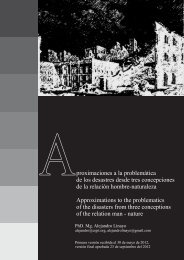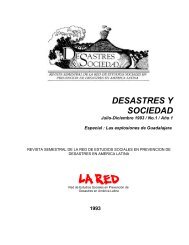Estrategias sociales de prevención y adaptación Social ... - La RED
Estrategias sociales de prevención y adaptación Social ... - La RED
Estrategias sociales de prevención y adaptación Social ... - La RED
Create successful ePaper yourself
Turn your PDF publications into a flip-book with our unique Google optimized e-Paper software.
Smaller initiatives for building on mounds however has proved more successful. In the<br />
pol<strong>de</strong>r of Overdiep, a plan was hatched, spurred by famers supposed to make space, to raise<br />
their farmsteads on mounds as an alternative (Roth and Winnubst, 2009).<br />
NB. Another adaptive, “living with the river” technology is exemplified by DuraVermeer’s<br />
(a building consultancy) floating houses, inspired by Asian traditions, were built at<br />
Maasbommel on the river Maas and attracted much international interest. Yet when I visited<br />
them in 2007 they were pretty unsaleable and a followup seemed unlikely.<br />
Combined Retention and Mounds: The North and South Meene Project<br />
Another example of mounds as a solution for flood risk in the East Netherlands is that of<br />
the Meene) (from Warner, et al., 2010). In 1998, heavy rainfall threatened four villages along<br />
the river Ijssel. Regional authorities prepared the area for evacuation and for cutting the<br />
dikes for controlled flooding. The cuts were only cancelled at the last minute, while evacuation<br />
was already in place. When the regional Farmers’ Union called a public meeting, angry<br />
resi<strong>de</strong>nts <strong>de</strong>man<strong>de</strong>d that dike cuts and evacuation would never be on the agenda again. The<br />
water authority duly promised this and <strong>de</strong>ci<strong>de</strong>d that the Meene area was to be a retention<br />
area for regional flood safety purposes. Local resi<strong>de</strong>nts would be protected by dikes in case<br />
the <strong>de</strong>tention area was to be used in a flood. Local resi<strong>de</strong>nts however opined the proposed<br />
dikes” locations had been planned too close to their houses, while farmers believed their interests<br />
had been sacrificed for the safety of downstreamers, and that they had been presented<br />
with a fait accompli. The Water Board <strong>de</strong>vised an alternative: Instead of diking up resi<strong>de</strong>ntial<br />
areas in the retention area, buildings and roads were to be placed on small elevations<br />
(mounds) to ensure dry feet. Some resi<strong>de</strong>nts <strong>de</strong>ci<strong>de</strong>d to lobby the local authority who dragged<br />
their feet on changing the local town and country planning. To meet the European<br />
<strong>de</strong>adline, implementation would have to start without the formal planning procedure being<br />
finalised. Inhabitants drove the price up for compensation.<br />
While this incentive helped persua<strong>de</strong> one farmer opponent to terminate his operation<br />
and offered up land, a small group was still prepared to block everything, which would not<br />
only imperil the project but in so doing also resi<strong>de</strong>nts and land owners . The Farmers’ Union<br />
<strong>de</strong>ci<strong>de</strong>d to reach out to the other resi<strong>de</strong>nt stakehol<strong>de</strong>rs more, and came to act as a go-between<br />
(broker) between resi<strong>de</strong>nts and the authorities. In this role they reached an agreement<br />
with the Water Board.<br />
Why are these plans resisted A clue is that they the new plans are externally imposed<br />
and not rooted in community experience any more. Another blue seems to be that returning<br />
land to water is more counterintuitive than building mounds. We will <strong>de</strong>lve into those in the<br />
section below.<br />
<strong>La</strong>nd Reclamation and Building with Nature<br />
Currently the dumping a large amount of sand into the sea to foster land accretion due to<br />
largely predictable morphological processes. It is now also proposed as a solution for Bangla<strong>de</strong>sh<br />
where land scarcity is chronic. This form of land reclamation, sold as “best practice”<br />
may not be so new either.<br />
39



